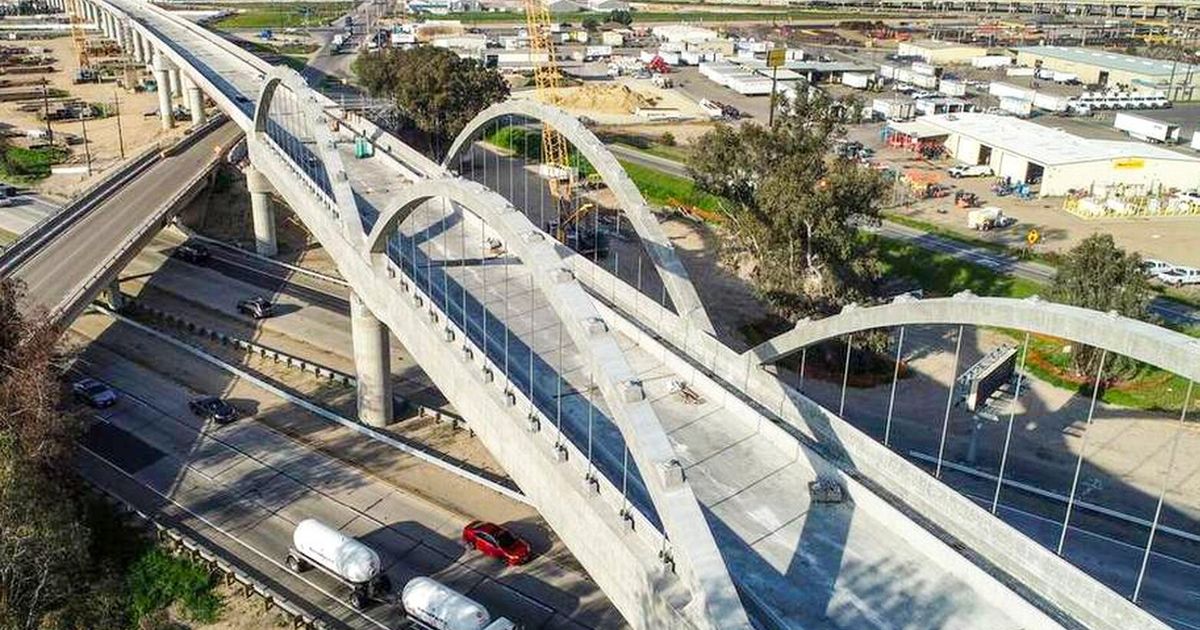- cross-posted to:
- britishcolumbia@lemmy.ca
- canada@lemmy.ca
- cross-posted to:
- britishcolumbia@lemmy.ca
- canada@lemmy.ca
I hope they plan the segments better than California’s HSR.
I also think they should plan it to also be a backbone to regional rail as well. For Portland, you could put stations in Vancouver, WA and some locations south.
Hopefully Oregon participates as well to extend the system to Eugene.
Hi, I’m a man from the internet who has spent entirely too much time watching urbanist YouTube, and I’ll argue with anyone, anytime, over anything.
What’s wrong with the CAHSR segments?
The initial segment is a train to nowhere which won’t provide any real destinations.
The system should have been built in two segments. The north segment should have been to leave San Francisco and make it past Gilroy in order to provide connectivity with a major city. The south segment should have been the Phase 2 segment connecting LA to San Diego, including a connection from Union Station to LAX in time for the 2028 Olympics.
That way, the north section sees ridership as a way to access SF while the Amtrak line between LA and San Diego can fall into the ocean after the replacement is finished. This could also possibly help with Brightline West as it could connect to the south segment through the Cajon Pass, making the system more valuable.
There’s a few good videos on this, but the central valley isn’t nowhere. Along the central valley alignment, just talking about the cities where stops are planned, you’ve got a little over a million people who would be delighted to have an easier way to get to San Francisco or LA than a short-haul airline or a car, and that’s not counting people from satellite towns and cities that might use the rail as well. I live in Merced, where the central hub of the CAHSR is planned, so I feel that I can speak with a little authority here. Yes, outside of the metros, the valley is dazzlingly empty, but Bakersfield alone is basically the same population as Tulsa, OK. Fresno is the 33rd most populous city in the country. It’s not exactly like they’re trying to connect to Nome, Alaska here.
If you’d like to watch something a little more entertaining than me, banksrail did a pretty good video on it here: https://youtu.be/66CO4bHFlqY
There’s also a political question that can’t be ignored. The valley is really, really conservative. Building the rail through the valley second gives fox news time to rile up the conservatives here and mount resistance to the project, which already saw quite a lot of resistance as-is. This is a case of swallowing your frogs first; once the valley’s out of the way, building in the metros will be politically easier, and the conservatives now have a stake in the venture’s success unless they really just want the San Joaquins part 2: Going Past Cows Fast As Fuck. There’s also the question of political will in the cities. San Francisco and LA politicians in the state legislature have made it abundantly clear that they want theirs and couldn’t give a fuck if the valley gets a goddamn thing. One of the loudest efforts to torpedo the CAHSR recently was led by politicians from SF and LA that wanted to divert all CAHSR funding meant to benefit almost the entire state into their own local transit authorities. So, it’s as likely as not that once LA and SF got what essentially amounts to high speed commuter rail segments, they’d brush their hands off and say “good job, team” and either lose interest in or try to nuke the remainder of the project.
The whole point of this project is to connect San Francisco with Los Angeles, so you are going to need to build through the Central Valley to do so. I don’t see SF and LA giving up on the project after they get better commuter rail. It is really more trying to build more useful initial operating segments first.
And the Central Valley cities are car dependent cities with poor mass transit. There is a good reason to take the train into SF or LA, but why take it into downtown Fresno? Even when you get to the train station, are you going to be able to get to the building you want to go to? I can easily see operations start on the first segment and there are tons of stories of empty trains used to try to kill the rest of the project.
And as for the politics, it seems like it would be a better political sell to Fresno to get them to agree to a train going to San Francisco than it would be for a train to Bakersfield.
And if the project stalls, it is better that it stalls out with useful track.
Well, the Bay Area is using CAHSR money to upgrade Caltrain already. That project should be done in a year or two.
What Rendon wanted to do in Socal with Metrolink was to use the money to not do any electrification and use battery-electric trains, which would have been useless.
I agree that battery trains would be useless.
Better urban environments is a fight that’s going to have to happen (and currently IS happening under Newsom) all along the HSR alignment, including LA and SF. Central valley cities tend to look like a bomb went off that decapitated any building taller than two stories, but that’s something that can be changed with consistent effort over time, and I believe that it will. One of Newsom’s top priorities right now is housing affordability and homelessness, and his administration’s been fighting with (mostly bay area) NIMBY cities that are desperate to keep their densities low and their housing supply slim. YIMBY movements are starting to spring up all around California, and I’ve got hope that reforms to promote better, denser urbans are coming down the pipe. What’s more is that CAHSR, in addition to several other bills, are helping to find more robust transit and transit oriented development across the state.
As-is, yes, travelling by public transit in central California blows ass. The only saving grace, really, is that CAHSR actually goes THROUGH the cities (for the most part, I think Visalia is the exception), so that you’re automatically at your destination when you step off. This is compared to riding the San Joaquins, where it’s a total crap shoot whether you’ll get dumped in the middle of nowhere (Turlock, Modesto, Madera I think, probably a few others) or somewhere actually kind of useful. So, if our cities can get their shit together, and I think they can in time before the rail opens, then it could actually be a pretty nice experience.
Yeah, if.
I get that HSR will be a benefit to those cities over time, but a lot of that initial benefit would come from connecting a car dependent area to a car hostile area to encourage people to start to take the train. Being close to the train could then spur increased density in housing, which could provide a nucleus for mass transit.
I would definitely go south of the Merced Y before going north, but I feel like the value of HSR to those communities is connecting them to either Los Angeles or San Francisco, not to other Central Valley cities.
I’m not in Cali so haven’t spent a whole bunch of time looking at this, but isn’t the general consensus that the route they ended up taking was extremely non direct and far more expensive then it needed to be so they could pass through/by very small cities?
The route selection isn’t that big of an issue. CAHSR was always intended to help connect the Central Valley to LA and SF. Merced, Bakersfield, and Fresno aren’t that small, and they aren’t that out of the way either.
SNCF’s bid did use the I-5 RoW, which doesn’t pass through these downtowns and would have required connecting spurs in the Central Valley. It would have been cheaper most likely, but not passing through the valley cities’ cores would probably have hurt support for the project and limited the impacts it could make for the rest of the state’s economy. (These cities (or at least Fresno) have since rejected having HSR go through their downtowns, but that’s a new problem.)
Valley metros are still bigger than a lot of ‘large’ metros in the rest of the country. Fresno and Bakersfield are 500,000 and 400,000 people, respectively. Visalia and Merced are around an additional 100,000 each. The central valley is hugely car dependent, even our airports tend to be on the pitiful side, and driving from the valley to LA or San Francisco fucking s u c k s. Currently, the only alternative is taking the San Joaquins, which runs about once every 2 hours and roughly travels a little slower than a car anyway, due to its shared alignment. Amtrak is doubling the service frequency this fall, but as it stands, that’s what it is. Cutting out the valley metros would have been basically leaving ridership (money) on the table and forcing valley citizens to continue on with car dependency for long trips or building a bunch of bullshit spur lines that people likely wouldn’t have messed with.
Mostly, the attitude in the central valley is just one of beleaguered exhaustion with the construction. These contractors have left a lot to be desired, and construction is proceeding at a pitiful pace while contractors keep spamming the HSR authority with bullshit overages (one submitted a six-figure cost overrun for long distance calls in 2017. Like, wtf, no, caveat emptor motherfucker, it’s not our fault you’re too stupid to use Skype). We just want to see the train roll before we all die of old age.
$200 million for a study I assume. Christ this stuff does not need to be so expensive. Why do we continue to be so bad at this?
Yes, please! A bullet train up/down the west coast would be simply amazing!
Yeah. Bc to Portland would be nice, but bc to San Diego would be amazing.
In my view a fast and reliable bullet train from BC to Portland (or even better, down to Eugene) would supercharge the entire PNW region economically speaking.
Not only would it improve business connections between major cities, but it would also make it much more viable to live and develop all of the towns along the corridor. More affordable places to live and commute from without being completely isolated from the jobs and culture of three amazing cities. On top of that, tourism within the region could boom, both as people who live in one city might regularly visit the others, but also because people who are visiting from outside of the region would have easy access to the combined interest of all of them.
When you look at how the shinkansen totally transformed Japan and the potential economic upsides that could come from the investment, it seems like a no-brainer to me.
oh i completely agree. im just hoping for further, or at least plans for it to go further. and not just north and south either. we need to be able to connect east and west as well. spokane and boise shouldnt be forgotten about either. though getting though or over the mountains could be expensive.
I just drove from Bellingham to Portland. Let me say that the I5 corridor is an absolute death trap. Not to mention that Seattle traffic is the absolute worst.
Please for the love of all that is good and holy make this happen. Make the rails dedicated to passenger trains only. Have multiple departure times in the early morning and afternoon after 18:00. AND be reliable AND on time!
Good! Show those Californians how it’s done.
YES. PLEASE.
For complete engineering plans to include routes, cost to procure routes, actual cost of materials, etc. 500 million for a complete package - and then seek funding. Of course you’re talking Seattle to San Diego… right? And an airtight contract. No change orders needed.
People keep wanting these long as fuck HSR routes and, well, that’s really not the space HSR fills in transport infrastructure. HSR generally replaces short-haul airline trips, which is why it would be YUGE for LA-SF, the TX metros, etc. But it still tends to lose out to airlines on long-haul trips because, eventually, jets are just faster. China does do these crazy long routes, and I’m not really sure why, unless their air infrastructure is really whack or something. I THINK that their longest lines still fulfill the role of replacing short-haul flights, it’s just that it didn’t make sense to separate the alignments when it’s all along the same line anyway.
Basically, HSR is a huge PITA to build right, a well worthwhile PITA, but a PITA nonetheless. That makes it really expensive on the frontend, on top of not being competitive with air over very long distances. What would be more realistic for long-haul rail transit would be something closer to Brightline, which isn’t true HSR. They use a different FRA rail class than true HSR, and don’t achieve the same speeds, but it’s still reasonably fast (in the triple digits), doesn’t requires extremely specialized stock, and it’s a lot cheaper to build. Replacing Amtrak’s long-haul lines, like the Coast Starlight, with dedicated class six or seven alignment would mean that they could reasonably sustain about 125 mph. It’s currently a 36 hour trip (notably, 2x the time to drive from Seattle to LA), but that would bring it down to about (1,135 mi / 125 mph, mi cancels leaving us with) 9 hours. I can’t really set aside two days to take a train to Seattle, but I could plausibly set aside 9 hours, especially given that it’s a little over half the time to do the drive. Heck, you could even make it a sleeper train. I’d do that over an airline in a heartbeat. The California Zephyr runs from Sacramento to Chicago, IIRC, and takes about a week. On its own class 7 alignment, that would be (2045/125) just 16 hours. That’s a hell of a lot better than a week, and half the time of driving.
So, HSR for long distances isn’t really that good or valuable, IMO, but that doesn’t mean that we can’t do highER speed rail for long distance travel.
Rofl. For context to build light rail in the Seattle area the region is sending $50+ billion on st3. I want this but it’s not gonna be cheap, and nor should it be. We should want it done right the first time.
The issue is that, despite spending more money than any other country by an order of magnitude (excepting maybe the UK) per mile of track, we don’t get it done right the first time.
SF’s Central Subway which was, at one point, the most expensive rail project (light or otherwise) per mile of track in the world had to get the contractor to go in and completely replace the rails because they had tried to sneak substandard steel past the city.
The megacontractors who build these projects do not deliver quality, they do not deliver when they say they will, and they do not deliver for the cost they bid at. They do make a killing though.
The fuck would I wanna go to Portland for. Unless you guys are paying lol





